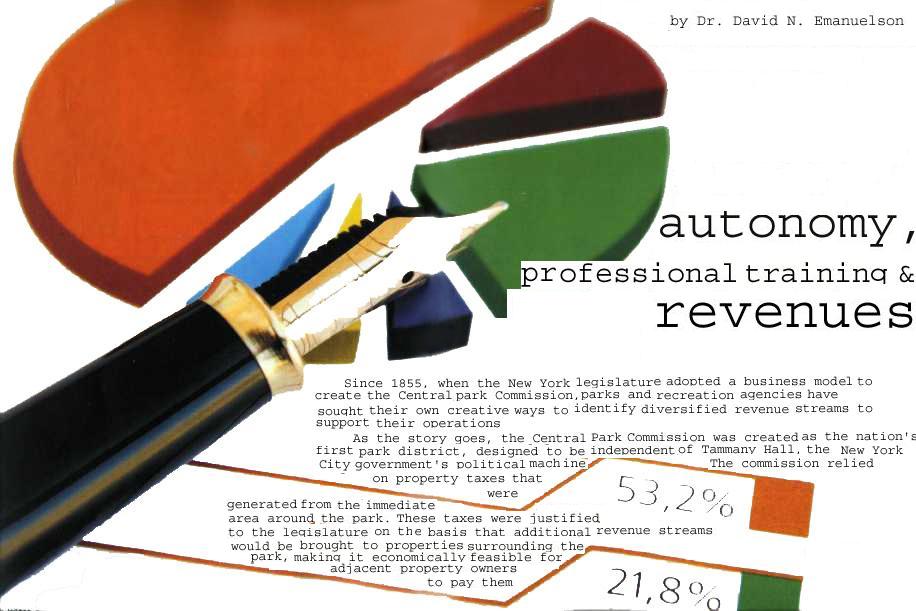 |
Home | Search | Browse | About IPO | Staff | Links |
 |
Home | Search | Browse | About IPO | Staff | Links |

An important actor in the Central Park story is Frederick Law Olmsted, the park's first superintendent. As the story goes, Olmsted was able to implement his vision for the park because he could be autonomous from Tammany hall. The Central Park Commission's independent taxing authority provided Olmsted the ability to secure funding without paying homage to city's political rainmakers or hiring their partisan cronies or pet contractors. The history of the creation of Central Park is an extreme example of how the inherent political nature of city government can make it more difficult for park and recreation professionals to pursue professional goals for their agencies. The autonomy of local park, recreation, conservation and special recreation districts can help bring fiscally efficient and professional services to the public. Measuring Autonomy In an attempt to answer that question, in his 1986 doctoral dissertation written for West Virginia University, Van Anderson studied autonomy and revenue. He compared levels of autonomy that West Virginia municipal parks and recreation departments exhibited to the levels of fees they were allowed to charge for services. Anderson's primary hypothesis was the more autonomous a park and recreation system is, the greater the percentage of the budget that will be from self-generated revenues (fees). From his data, Anderson created an autonomy index, which he compared to agencies' budgets. Anderson's findings suggested that when it comes to percentages of budgets' fee revenues, agency autonomy matters. He found that for highly autonomous agencies, an average of 47.3 percent of the operating budget was from fees. For agencies exhibiting low levels of autonomy, only 10.1 percent of operating budgets were derived from fees. In 2002, I conducted a somewhat broader study. In this study, parks and recreation administrators in Illinois were asked to rate their levels of budgetary autonomy on a Likert scale. They were also asked the percentages of their budgets derived from fees and the number of programs that their agencies operated.
Form of Governance and Autonomy The findings from the combined data from both states show that agencies with high levels of autonomy generated 35.3 percent of their budgets from program fees, while agencies with low levels of autonomy generated only 23.5 percent of their budgets from program fees. This continues to suggest that autonomy makes a difference. The question becomes: Does the structure of government create autonomy? Separating park districts and parks and recreation departments into two groups and comparing their averages addressed that question. In the comparison, Illinois park district administrators reported a level of autonomy that was 36.2 percent higher than their counterparts at parks and recreation departments in Illinois and Wisconsin. Similarly, the total number of programs offered by park districts was 12.7 percent higher than parks and recreation departments. 32 Illinois Parks & Recreation www.ILipra.org If autonomy is related to structure of government and to percentage of budgets generated from fees, there should be a relationship between the structure of government and percentage of budgets generated from fees. That hypothesis was also tested.
Within the Illinois and Wisconsin data, it was found that agencies that were managed by people having a master's degree in the parks and recreation field offered 19.6 percent more recreation programs than agencies with administrators who didn't have a master's in the field. Similarly, agencies that were managed by people having a master's degree in the field generated 18.1 percent more of their operating budgets from fees than agencies where the administrator did not have a master's degree in the parks and recreation field The effect of agency administrators having a CPRP was even more pronounced. Park districts and parks and recreation departments in Illinois and Wisconsin that were led by administrators who had CPRPs offered 43.4 percent more total recreation programs than agencies where the director was not a CPRP. Considering the percentage of their budgets that were generated from fees, the differences were nearly the same. www.ILparks.org May/June 2007 33
Conclusions But the studies are relevant for another reason. They let us know that the structure of government does make a difference. Evidently Olmsted knew it, which may be why he came to Illinois and did so much of his work here. Dr. David N. Emanuelson 34 Illinois Parks & Recreation www.ILipra.org |
|
|